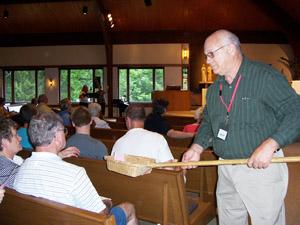
By Celine Klosterman
Martha Popson doesn’t often leave her home just outside Knoxville long enough to miss weekend Mass at the town’s St. Anthony Church. But when she’s not there to put a donation in the collection basket, she tries to make up the missed contribution the following weekend.
Signing up for her parish’s automated, electronic giving option would mean she’d never miss a donation, “but I like the personal touch of the paper envelope in the basket,” she said.
However Catholics choose to give, some parishes are trying to remind them of the importance of doing so consistently. Leaders at several parishes notice donations from parishioners drop during the summer vacation season, sometimes straining church budgets.
“It puts us on edge,” Father Jason Crossen said. He’s pastor of Ss. Mary & Mathias Parish in Muscatine, where donations dip 8 to 9 percent in the summer, according to Linda Niedergeses, business manager for the 1,260-family parish. That drop impacts the parish’s ability to keep up with regular expenses, which include wages and salaries for numerous employees at Saints Mary and Mathias Catholic School, the priest said. “We usually have to borrow from savings.”
Decreased donations in the summer sometimes cause Prince of Peace Parish in Clinton to do the same, according to Dave Schnier, business manager for the 1,700-family parish. Envelope donations can be $6,000 to $7,000 less in June and July than average, he said.
“We still have most of our operating bills to pay for: insurance, wages, utilities, supplies, grass mowing and parish school support, which we pay every month, even when school is out for summer.”
In Coralville, donations from summer visitors to St. Thomas More Church don’t make up for the contributions lost when St. Thomas More parishioners miss weekend Mass during a vacation, said Lee Gullickson, parish finance administrator. From June to August, the decrease in giving runs between $500 and $1,000 each week, he said.
But he said the impact on the 890-family parish is minimal. Larger contributions between Thanksgiving and Easter offset smaller summer donations, and St. Thomas More budgets for a dip in giving in June, July and August. For example, in hopes of bringing in extra income in the spring, the parish offers members a discount on religious education tuition if they pay by May 31.
St. Thomas More, Ss. Mary & Mathias, Prince of Peace and other parishes also find at least a partial solution in automated, electronic giving. Judy Johnson, parish administrator at Our Lady of Victory Church in Davenport, said the dip in summer donations at the 1,374-family parish is slight, thanks largely to the parish’s emphasis on electronic giving. Each month Our Lady of Victory processes 136 automated, offertory transactions totaling $14,559, which in May made up about 15 percent of adults’ donations, she said.
For parishioners who can’t make it to Mass at Our Lady of Victory but prefer to give a check, the parish sends out pre-printed return envelopes monthly.
Around the time Sacred Heart Parish in Newton began offering its Autoshare Giving program in 1998, the parish determined donations would increase $3,000 to $5,000 annually if all consistent contributors signed up, said Kathy Hammerly, stewardship coordinator. Now, about 34 percent of annual income for the 750-family parish comes through Autoshare Giving, according to Sacred Heart.
“The essence of stewardship is that it’s planned, intentional and proportionate,” Hammerly said. “I think if people use Autoshare, it helps them be better stewards of the gifts God’s given them.”
But not all parishioners are comfortable with donating electronically, Fr. Crossen observed. And no matter how they give, repeatedly asking them to do so can prove challenging, he noted. Ss. Mary & Mathias Parish recently undertook two fundraising campaigns — for its Mazzuchelli Center, a $1.8 million, faith-formation building dedicated in late 2010, and for the Diocese of Davenport’s capital campaign last year. “So for us to say we need more money is hard to do.”
Many causes compete for Catholics’ donations, Colleen Evans said. She’s parish accountant at St. John Vianney Church in Bettendorf, which has about 1,700 families. She noticed that parishioner donations from May to August 2010 were about 7 percent lower than during the first several months of last year, but saw virtually no change in summer 2009. Last year Catholics may have wanted to give to several worthy recipients — the parish, the diocese and charities helping people recover from Haiti’s 2010 earthquake and Pakistan’s 2010 floods, she said. “But it’s hard for parishioners to donate to everything.”
It’s not that Catholics aren’t generous, Fr. Crossen said. “The biggest issue is awareness. We just want people to know that when they pay attention — or don’t pay attention — to their giving, it does impact us.”
What is electronic giving?
To donate to a parish through an automated, electronic giving program, a parishioner typically fills out a form stating:
• His or her bank or credit union account number and routing number
• The amount of money the parishioner would like to donate electronically
• When and how often he or she would like the amount to be automatically donated.
He or she may also need to provide a voided check with the form.
The service eliminates the need to write regular checks and to prepare contribution envelopes for the collection basket. Parishioners can typically change or cancel their donations by providing a written notice.








